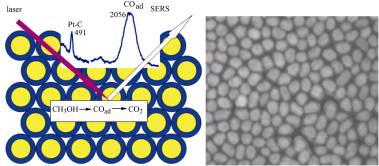1 Fleischmann, M.; Hendra, P. J.; McQuillan, A. J. Chem. Phys. Lett. 1974, 26, 163.
2 Camden, J. P.; Dieringer, J. A.; Zhao, J.; Van Duyne, R. P. Acc. Chem. Res. 2008, 41, 1653.
3 Tian, Z.-Q.; Ren, B.; Li, J.-F.; Yang, Z.-L. Chem. Commun. 2007, 34, 3514.
4 Li, J.-F.; Huang, Y.-F.; Ding, Y.; Yang, Z.-L.; Li, S.-B.; Zhou, X.-S.; Fan, F.-R.; Zhang, W.; Zhou, Z.-Y.; Wu, D.-Y.; Ren, B.; Wang, Z.-L.; Tian, Z.-Q. Nature 2010, 464, 392.
5 Shi, M.-Q.; Lang, X.-L.; Ma, C.-A.; Chu, Y.-Q.; Chen, Z.-Y.; Yu, B. Acta Chim. Sinica 2011, 69, 1029 (in Chinese).(施梅勤, 郎小玲, 马淳安, 褚有群, 陈赵扬, 俞彬, 化学学报, 2011, 69, 1029.)
6 Zhao, D.; Wang, Y.-H.; Yan, B.; Xu, B.-Q. J. Phys. Chem. C 2009, 113, 1242.
7 Lu, L.-H.; Wang, H.-S.; Xi, S.-Q.; Zhang, H.-J. J. Mater. Chem. 2002, 12, 156.
8 Hu, L.-F.; Chen, M.; Fang, X.-S.; Wu, L.-M. Chem. Soc. Rev. 2012, 41, 1350.
9 Lin, Y.; Skaff, H.; Emrick, T.; Dinsmore, A. D.; Russell, T. P. Science 2003, 299, 226.
10 Li, Y.-J.; Huang, W.-J.; Sun, S.-G. Angew. Chem., Int. Ed. 2006, 45, 2537.
11 Hu, J.-W.; Zhao, B.; Xu, W.-Q.; Fan, Y.-G.; Li, B.-F.; Ozaki, Y. J. Phys. Chem. B 2002, 106, 6500.
12 Zhang, X.-J.; Mei, J.-H.; Ni, D.-D.; Guo, Q.-H.; Xu, M.-M.; Yao, J.-L.; Gu, R.-A. Chem. J. Chin. Univ. 2011, 32, 1563 (in Chinese).(张雪姣, 梅金华, 倪丹丹, 郭清华, 徐敏敏, 姚建林, 顾仁敖, 高等学校化学学报, 2011, 32, 1563.)
13 Frens, G. J. Nature Phys. Sci. 1973, 241, 20.
14 Li, J.-F. Ph.D. Dissertation, Xiamen University, Xiamen, 2010 (in Chinese).(李剑锋, 博士论文, 厦门大学, 厦门, 2010.)
15 Lin, Y.-H.; Cui, X.-L.; Yen, C. H.; Wai, C. M. Langmuir 2005, 21, 11474.
16 Tian, Z.-Q.; Ren, B.; Mao, B.-W. J. Phys. Chem. B 1997, 101, 1338.
17 Ren, B.; Li, X.-Q.; She, C.-X.; Wu, D.-Y.; Tian, Z.-Q. Electrochim. Acta 2000, 46, 193.Ren, B.; Huang, Q.-J.; Cai, W.-B. J. Electroanal. Chem. 1996, 415, 175.


